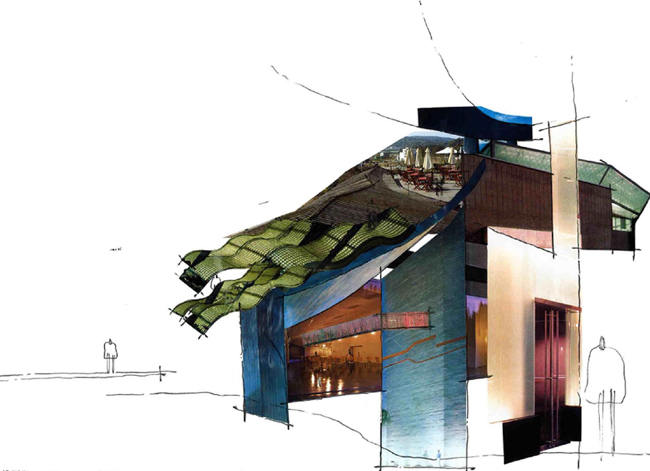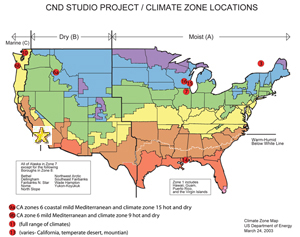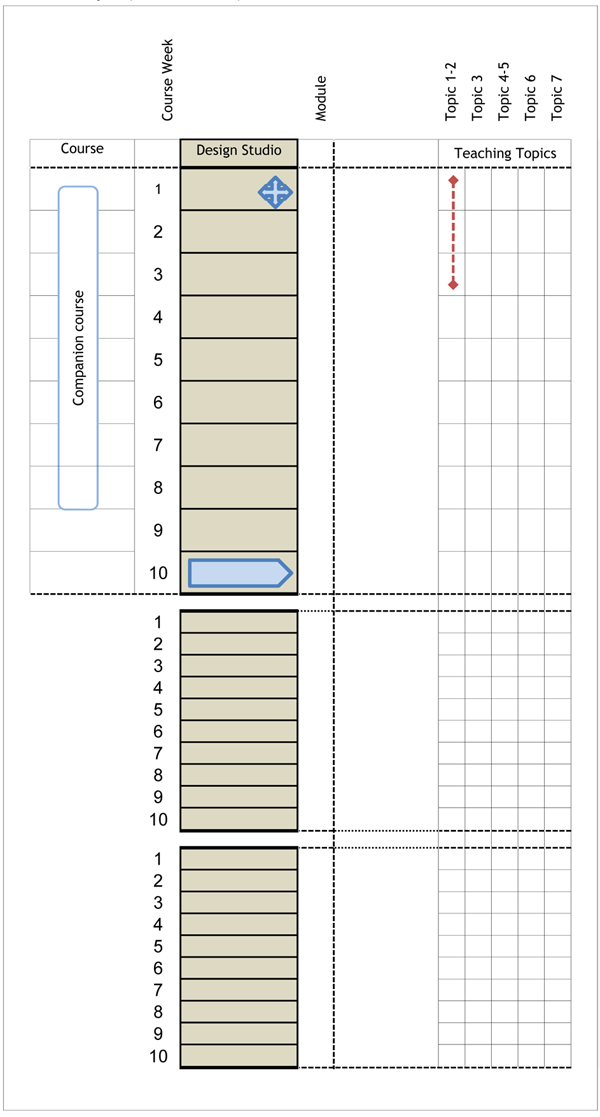Seven Frames of Reference
Senior Architectural Design Projects
Pedagogical Overview, Philosophy and Strategies

Design Performance Objectives |
Seven Frames of Reference
Exploring humor as a healing art
|
Student: Kylie Gaines |

The climate of instruction is HOT-ARID. The principles of the projects could be applied to any climate zone, and many are specifically designed to address multiple climate types. |
|
Arch 481 Senior Architectural Design Project Studio/
Arch 492 Senior Design Thesis Seminar
Sandy Stannard
Associate Professor of Architecture
Cal Poly San Luis Obispo
stannard@calpoly.edu
The projects represented in this submission are year-long, individual undergraduate thesis projects. Due to the nature of this type of individual project, the lessons are thus individual and are taught/learned individually (in response to the particular conditions of each unique project), even when there is commonality in the general expectations in terms of student output. Thus the broad “challenges” result in varying design responses from the students. They work closely with me as their instructor to arrive at solutions appropriate to their given project circumstance. Group learning happens as students observe their colleagues responses to their project circumstances (in class; at critiques; etc). In this way, these examples perhaps exemplify applied learning, as students apply their knowledge to the distinctive challenges of their chosen projects. As a result, this submission is presented more as a thoughtful “framework” of carbon neutral design issues (leading to a comprehensive design project) rather than as a list and description of project exercises.
Special Topic: Energy Simulation
Currently under development! [We continue to explore all the available tools. I greatly look forward to further expansion in this area]. Currently we are using Climate Consultant for site/climate analysis and HEED for residential projects. We are also doing mixed mode heating/cooling hand calculations (internal loads and cross ventilations strategies) for larger scale buildings. In addition, students do either computer solar analyses (to determine solar penetration for heating/cooling issues) OR daylighting models (for lighting quality). We are trying to get Ecotect started; and a handful of students attempted the Energy Plus plug-in for Sketch Up (no significant results to report as yet; project under way). All students are asked to use the carbon calculator available at buildcarbonneutral.org.
The course and projects will respond to a range of NAAB Student Performance Criteria, the most significant of which are:
#15. Sustainable Design
Understanding of the principles of sustainability in making architecture and urban design decisions that conserve natural and built resources, including culturally important buildings and sites, and in the creation of healthful buildings and communities
#17: Site Conditions
Ability to respond to natural and built site characteristics in the development of a program and the design of a project
#19: Environmental Systems
Understanding of the basic principles and appropriate application and performance of environmental systems, including acoustical, lighting, and climate modification systems, and energy use, integrated with the building envelope
#21: Building Envelope Systems
Understanding of the basic principles and appropriate application and performance of building envelope materials and assemblies
#28: Comprehensive Design
Ability to produce a comprehensive architectural project based on a building program and site that includes development of programmed spaces demonstrating an understanding of structural and environmental systems, building envelope systems, life-safety provisions, wall sections and building assemblies and the principles of sustainability (to a more limited degree given the beginning design nature of the course projects) |
|
|
Information about the Course and Projects |
The project I have chosen to illustrate
• compilation PDF
• thesis syllablus
• thesis abstract submittal
• thesis charrette |
Philosophy of the Studio Instruction |
Preparing in the Present for the Future
Per the submission request, the philosophical statement is included but embedded. In this case, the statements are included at each sub-heading.
General Philosophy: Preparing in the Present for the Future
Buildings are among the more durable artifacts that a society produces with causal affects on the environment that far outlive their makers. As thoughtful, educated designers, we are the stewards not only of creating meaningful spaces for people but also for respecting the environmental setting of these places. Man’s existence within the earth’s fragile ecosystems (of which we are a part) calls for sensitive, responsive, appropriate design. It is our responsibility to search for a fitting co-existence, a symbiotic relationship that neither impoverishes the planet nor our human experience on it.
1] Architecture + The Landscape
Philosophy: Place-making is essential in the creation of meaningful architecture, no matter what the scale. Scale of settlement patterns and appropriateness of setting are vital issues in any successful architectural endeavor. The specifics of any given place, its genius loci, must be understood and respected. In addition to phenomenology and place, creating symbiotic relationships with the land should be the goal of all of our built artifacts.
2] Architecture + The Environment
Philosophy: Sensitive architectural solutions respect and should celebrate the environment. This includes an appreciation for the local (geographies, bioregions, seasons, micro-climates, etc.) as well as a response to the global (energy sources and resources, etc.). Because buildings are energy consumptive, this is an arena in which architects have the opportunity to innovate, with the aim of achieving “carbon neutral” buildings by 2030 as posed by the Architecture 2030 Challenge. Learning from the past, learning from other cultures, and taking advantage of technological innovations, architects can design resourceful, delightful environments.
3] Architecture + Its Inhabitants
Philosophy: Even the best sustainably designed environment will not be useful unless it elicits “delight” in its users. Creating spaces that allow people to experience joy, health, comfort, and well-being is essential. Exploring material tactility, thermal delight, and inspiring luminous environments are a few of many methods to this end, moving toward a multi-sensory architecture.
4] Architecture + Materiality
Philosophy: Materials are the basic building blocks of an architect’s language. Exploring the poetic potential of structure and materiality is the goal here. Further, it is our responsibility to understand the pivotal cradle-to-grave-to-cradle issues related to material choices, with consideration for the energy consumption involved in extraction as well as recycling. Thus, a designer manipulating any given palette of materials must balance issues of material source with appropriate and inspiring form and structure.
5] Architecture + Technology
Philosophy: The appropriate use of technology should be the aim of any project. This includes not only the technology used in the design process but also in construction, operation, and maintenance. Use of appropriate simulation tools for design as well as performance will be part of studio activities
6] Architecture + the Social-Cultural-Economic-Political Context
Philosophy: All architecture is physically contextual (whether consciously conceived or not); it is also always political (whether consciously calculated or not). The primary goal should be to make architectural proposals that are strategic rather than reactive, appropriate to the space and time of the given situation.
Particular topics and issues vary per project according to the project situation.
7] Architectural Integration: The Paradigm of Architecture
Philosophy: The ultimate aim of this topical sequence is to understand how our creative work reflects upon, questions, and relates to the broader field of architecture. Are we advancing the discipline or simply replicating the past? Are we improving our relationship with nature, or settling for the status quo? Are we creating stimulating, responsible environments or …….? To paraphrase Corbusier, we should aim to make the bad difficult and the good easy.
Addendum
Naturally, these topical issues are not discreet and they should overlap. The iterative design process will be a guiding principle. “Architecture + Nature” projects cover a multitude of scales and uses in a variety of site settings.
Continuing the Conversation Follow Up Discussion between Jim Wasley and Sandy Stannard
JW- What does it mean to studio pedagogy to teach carbon neutral design, and how do you validate such claims in the studio setting?
SS- Short, off-the-cuff comment: we are still in the investigative stages of “carbon neutral design.” As accessible verification tools become more readily available, we will be more and more able to verify our claims. At this point, our goal is to aim for carbon neutrality and do our best to verify the claim. Even as I write this, with access to these better evaluative tools, students are getting closer such verification. Keeping this all in context is vitally important however: in my case, I am working with undergraduate students and within the limits of the academic time frame (which cannot be compared to a professional architectural project, for example). I am challenging my students to make the most effective use of the time and knowledge that they’ve got, applying all this toward the goal of carbon neutral design proposals.

Studio Topics Key
TEACHING TOPICS PROFILED
1. Architecture + The Landscape
Demonstrate sensitive and appropriate site responsiveness (for both human appreciation and well-being as well as for the support of natural systems), according to project particulars. Through design, explore the meaning of “place.”
2. Architecture + The Environment
Demonstrate ecological responsiveness (given the particular nature of each project). Climatically responsive design is the minimum requirement.
3. Architecture + Its Inhabitants
Through design trials, explore the nature and meaning of “venustas,” while simultaneously balancing ecological design principles.
4. Architecture + Materiality
In the initial stages of their thesis development (while students are heavily engaged in writing and research), students are challenged with a 4-6 week “materials” charrette in which they are asked to design and construct a usable object that reflects some of the ideals that they are pursuing in their theses.
5. Architecture + Technology
During all phases of their projects, students are encouraged to utilize all available and appropriate technology to explore their ideas. They are required to do some 3D simulation modeling as well as energy performance modeling; in each case and in consultation with their instructor, they choose the tool appropriate for the task.
6. Architecture + Social, Cultural, Economic, Political Context
All students are challenged to consider the social, cultural, economic and political contexts of their chosen projects. As an instructor, I encourage students to select strategic projects, and then realize strategic solutions to those projects. No project is simply an object, or “building.” Every project is full of portent beyond its mere physical presence.
7. Architectural Integration: The Paradigm of Architecture
All students are encourage to pursue design integration in their projects, as they attempt to balance all issues ranging from the poetic to the technical, while simultaneously staying focused on essential ecological design issues (which is always at the forefront).
|
List of 10 critical issues in my teaching of Carbon Neutral Design |
See items 1 - 7 above.
|
10 student design mistakes that undermine the goal of Carbon Neutral Design |
Ten Student (and Mentor?) Mistakes Undermining the Goal of Carbon Neutral Design (in random order):
1. “True” evaluation (of energy performance, of carbon neutral design)
2. Over-complexity….of design solution
3. Over-simplification…of many project issues, including performance solution
4. Strategic choice and use of site and siting
5. Unrecognized potential of the uniqueness of all building surfaces (qualitative and well as performance properties)
6. Materiality (lack of understanding, in a multitude of ways)
7. Cradle-to-cradle issues (insufficiently considered)
8. Form driven solutions
9. Lack of consideration for the power (and location) of the sun (for so many potentially powerful reasons)
10. Lack of appropriate climate responsiveness
|
|
Range of Applicability in terms of CLIMATE |
ALL |
Range of Applicability in terms of TYPE |
ALL |
Reference Material |
Alexander, Christopher, A Pattern Language (New York: Oxford University Press, 1977).
Carson, Rachel, Silent Spring (Boston: Houghton Mifflin Co., 1962).
Drew, Philip, Touch This Earth Lightly: Glenn Murcutt in His Own Words (Duffy & Snellgrove, 2000).
Earth Pledge, Sustainable Architecture White Papers (New York: Earth Pledge, 2000).
Friedman, Thomas, Hot, Flat, and Crowded (New York: Farrar, Straus, and Giroux, 2008)
Guzowski, Mary, Daylighting for Sustainable Design (New York: McGraw Hill, 1999).
Heschong, Lisa, Thermal Delight in Architecture (MIT Press, 1979).
Kwok, Allison, and Walter Gronzik, The Green Studio Handbook (Architectural Press, 2006).
McDonough, William and Michael Braungart, Cradle To Cradle: Remaking the Way We Make Things (New York: North Point Press, 2002).
Leopold, Aldo, A Sand County Almanac and Sketches From Here and There (New York: Oxford University Press, 1989).
Mau, Bruce, Massive Change (London: Phaidon Press, 2004).
Mazria, Edward, “It’s the Architecture, Stupid!” (Solar Today, May/June 2003, p. 48-51).
Mazria, Edward, Passive Solar Energy Book (Emmaus: Rodale Press, 1979)
McHarg, Ian, Design With Nature (Garden City: Doubleday/Natural History Press, 1969).
McPhee, John, The Control of Nature (New York: Noonday Press, 1989).
Miller, David, Toward a New Regionalism (Seattle: University of Washington Press, 2005).
Millet, Marietta, Light Revealing Architecture (New York: Wiley + Sons, 1996).
Orr, David, The Nature of Design: Ecology, Culture, and Human Intention (New York: Oxford University Press, 2002).
Pallasmaa, Juhani, The Eyes of the Skin: Architecture and the Senses (London: Academy Group Ltd., 1996).
Pollan, Michael, In Defense of Food (New York: Penguin Press, 2008)
Portoghesi, Paolo, and Erika Young, Nature and Architecture (Milano: Skira, 2000).
Reisner, Marc, Cadillac Desert: The American West and Its Disappearing Water (New York: Penguin Books, 1993).
Steffen, Alex, Ed., World Changing: A User’s Guide for the 21st Century (New York: Abrams, 2006).
Stein, Reynolds, Grondzik, Kwok, Mechanical and Electrical Equipment for Buildings, 10th Ed. (New York: John Wiley + Sons, 2006).
Tanizaki, Junichiro, In Praise of Shadows (Stony Creek: Leete’s Island Books, 1977).
Thompson, D’Arcy, On Growth and Form (London: Dover, 1992).
Van der Ryn, Sim and Stuart Cowan, Ecological Design (Island Press, 1995).
Wells, Malcolm, Gentle Architecture (New York: McGraw Hill, 1992).
Wines, James, Green Architecture (Koln: Taschen, 2000).
Yeang, Ken, Ecodesign: A Manual for Ecological Design (Academy Press, 2006).
Zelov, Chris, Ed., Design Outlaws on the Ecological Frontier (Easton: Knossus Publishing, 1997).
|
Duration of Exercise |
Each element of this work is a subset of a larger architectural/thesis project. |
Degree of Difficulty / Previous Knowledge Required |
Challenging. This is the terminal project of a degree. |
x |
|
|
|
|

